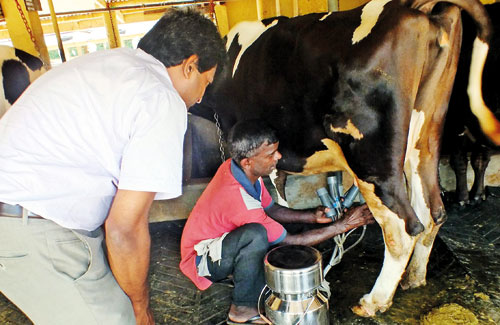Public, private sector leaders emphasise need for collaboration to improve dairy industry

File Photo of of a worker in the dairy industry
Sri Lankans are still consuming only a quarter of the recommended daily intake of milk with memories of the milkman bringing fresh milk to households in the morning and ringing his bicycle bell several decades ago having faded in present busy lifestyles.
At that time children enjoyed fresh milk in their homes and one or two milk cows had been looked after in home gardens of many of the rural and suburban areas.
But today there is no space to maintain cows in home gardens with concrete buildings wall to wall and there is neither fresh milk nor a milkman and we no longer hear his bicycle bell.
At a public dialogue earlier this week in Colombo on making the country self-sufficient in milk, a panel of public and private sector leaders agreed that through education, innovation and collaboration the local dairy industry can become a greater contributor to the Sri Lankan economy and better support the health and well-being of the nation.
The discussion, “Dairy: Flourishing farmers to nourishing Sri Lankans”, covered key topics such as the main trends that are driving the consumption of dairy, current barriers to meeting the local industry’s potential and how the government, industry and private sector can work together to overcome these barriers.
In order to accelerate the local dairy sector growth, there should be a paradigm shift in attitudes of the community from grass-root level to the top, Founder and President of Sarvodaya Shramadana Movement Dr. A.T. Ariyratne told the gathering at the BMICH in Colombo. The dairy industry has potential to contribute considerably to Sri Lanka’s economic development.
A traditional industry surviving thousands of years, milk production also plays an important role in alleviating nutritional poverty in all age groups and it is a source of extensive employment opportunities, he pointed out.
The public and private sectors should join hands to uplift the living standard of milk farmers and introduce new technology to the diary industry changing attitudes of the rural community to harness the maximum potential of dairy, he emphasised.
Drawing from his experience in working with rural communities in Sri Lanka, Dr. Ariyaratne, highlighted the positive impact a thriving local dairy industry can have on rural communities throughout the country.
“Every rural community must have access to clean water, sanitation and education, and I firmly believe that a prosperous dairy industry will play a vital role in helping to improve people’s lives,” he said.
Deputy Foreign Minister Dr. Harsha De Silva said the local dairy industry has huge potential to drive the economy.
“The agricultural sector employs 30 per cent of the Sri Lankan workforce, but contributes just 9 per cent of the national GDP,” he said adding that this tells us that the productivity of this sector has an immense potential to grow.
He noted that he has seen during a recent visit to New Zealand, agriculture and in particular dairy which has the potential to be a strong pillar of the country’s economy.
“Developing the local dairy industry can play a role in closing the local supply and demand gap, and uplift the livelihoods of small to medium farming entrepreneurs,” said Dr. De Silva.
Prof. H. W. Cyril, Chairman of the National Livestock Development Board stressed the need of collaborative efforts to drive commercially sustainable milk farming businesses which is required to help farmers better respond to the current challenges and lift both the quality and amount of milk they produce.
He noted that big commercial dairy firms should step into set up large scale commercial diary farms and introduce buy back arrangement for the benefit of small dairy farmers.
Dr. Amarasiri Chandrasoma, former Director of Animal Health for the Department of Animal Production and Health of the Ministry of Livestock, noted the common challenges including lack of farm business knowledge, the rising costs of farming inputs and the limited availability of both land and high-quality cattle.
These are the challenges affecting Sri Lanka’s 300,000 small-scale dairy farmers, which together currently produce around 80 per cent of local milk supply. On average, these farms have only three to five cows, and are run as family businesses with limited resources and inadequate farm management knowledge, he disclosed.
Sharang Pant, Managing Director of Nielsen Sri Lanka, revealed recent data indicating that people around the world are increasingly focused on healthier lifestyles, resulting in a rise in demand for healthy options such as dairy.
“While research showed that dairy features in the diets of most Sri Lankan households and year-on-year consumption continues to grow by 13 per cent, individual consumption still remains low,” he said.
Sri Lankans only consume half a glass of milk or its dairy equivalent each day. This is well below the recommended intake of up to two glasses of milk specified by the Ministry of Health, said Mr. Pant.
Sunil Sethi, Managing Director of Fonterra Brands Sri Lanka, said private sector players recognise their role in supporting these communities to help the dairy industry achieve its full potential.
He reiterated that increased taxes on milk imports will never create any impact on improving the local capacity in milk production but on the other hand create a shortage of milk and milk-based products in the growing demand of dairy.
“At present the country can meet only 30 per cent of the demand. But by curbing imports, we will run out of milk. The present need is an end-to-end solution to grow the local dairy industry” he said.
“We’re now three years into our 10 year commitment to invest Rs. 10 billion into dairy communities,” he added.
A key aspect of the company’s development programme has been working with partners and smallholder dairy farmers to develop local knowledge and farm management techniques, providing farmers with solutions that suit Sri Lanka’s unique agricultural requirements and create more sustainable, productive farms, he said.


